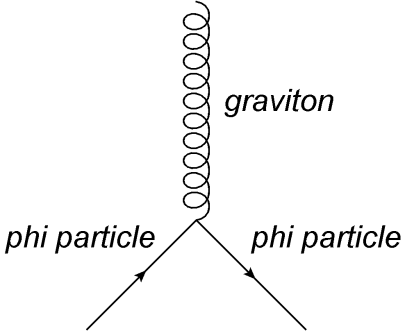Part One of a Series on N=8 supergravity
This blog is called four gravitons, so I ought to explain what a graviton actually is. Starting from that, I can begin to explain N=8 supergravity, gravity’s highly supersymmetric cousin.
Let’s start like we often do, with a quick answer that will take some unpacking:
Gravitons are the force-carrying bosons of gravity.
I mentioned force-carrying bosons briefly here. Basically, a force can either be thought of as a field, or as particles called bosons that carry the effect of that field. Thinking about the force in terms of particles helps, because it allows you to visualize Feynman diagrams. While most forces come from Yang-Mills fields with spin 1, gravity has spin 2.
Now you may well ask, how exactly does this relate to the idea that gravity, unlike other forces, is a result of bending space and time?
First, let’s talk about what it means for space itself to be bent. If space is bent, distances are different than they otherwise would be.
Suppose we’ve got some coordinates: x and y. How do we find a distance? We use the Pythagorean Theorem:
Where d is the full distance. If space is bent, the formula changes:
Here and
come from gravity. Normally, they would depend on x and y, modifying the formula and thus “bending” space.
Let’s suppose instead of measuring a distance, we want to measure the momentum of some other particle, which we call because physicists are overly enamored of Greek letters. If
is its momentum (physicists also really love subscripts), then its total momentum can be calculated using the Pythagorean Theorem as well:
Or with gravity:
At the moment, this looks just like the distance formula with a bunch of extra stuff in it. Interpreted another way, though, it becomes instructions for the interactions of the graviton. If and
represent the graviton, then this formula says that one graviton can interact with two
particles, like so:

Saying that gravitons can interact with particles ends up meaning the same thing as saying that gravity changes the way we measure the
particle’s total momentum. This is one of the more important things to understand about quantum gravity: the idea that when people talk about exotic things like “gravitons”, they’re really talking about the same theory that Einstein proposed in 1916. There’s nothing scary about describing gravity in terms of particles just like the other forces. The scary bit comes later, as a result of the particular way that quantum calculations with gravity end up. I’ll say more about that later in this series.

Hi, is there anyway gravity can or could have changed on earth between today and say 12,000 years ago?
With effects of ice age or the shift of ice age or anything further back that could have changed the gravity field or graviton components ?
LikeLike
So, it depends what you’re asking about.
How much gravity you feel on the surface of the Earth depends on the shape of the Earth around you. So an ice age or the like can lead to very small changes, because the weight of the ice changes the distribution of rock below. People actually use this sort of effect today to look for things like underground lakes.
This doesn’t change the force of gravity itself, of course. The same amount of mass still exerts the same gravity. It’s just a change in how much mass is near you, and thus how much gravity it’s exerting.
LikeLike
Pingback: Guest Post: Nathan Moynihan on Amplitudes for Astrophysicists | Sean Carroll
Could we think of the empty flat space as no gravitons at all and the curved space as some complicated object in the Hilbert space of gravitons? Is there some way by which it is reasonable to talk about “occupation number of gravitons” in gravitational field? Would getting things like black holes out of graviton interactions require some non-perturbative methods for graviton interactions?
LikeLike
Sort of. When people talk about gravitons, they’re small perturbations around a particular spacetime. That’s usually flat space, so perfect flat space is in some sense space with no gravitions. Beyond that, if you want to think of curved space as flat space plus gravitons, you’re right that you need to think nonperturbatively, at which point the particle picture is less useful. In either case you wouldn’t usually talk about occupation number since gravitons are bosons.
LikeLike
Does a theory of gravity by exchange of gravitons align in any way with theories of gravity dependent on entropy (Verlinde) or entanglement (Van Raamsdonk)?
LikeLike
Both Verlinde’s and Van Raamsdonk’s setups should look “like gravitons” at large enough distances/small enough energies. How much so is a trickier question. I have the vague impression that entropic gravity (at least as Verlinde does it) is supposed to differ more dramatically from “gravitons as normal” but I don’t really know the details.
LikeLike